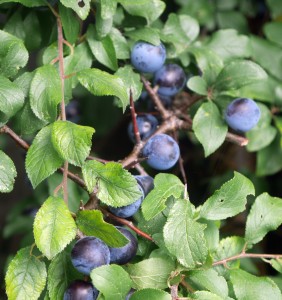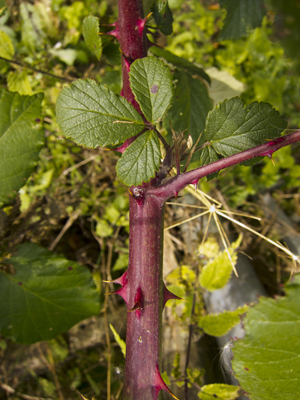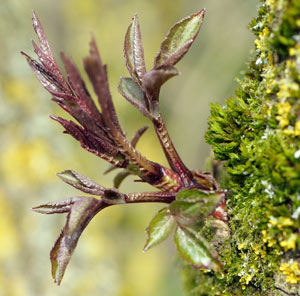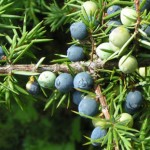Woodland types : scrub

Scrub is not woodland per se, but it is often found where woodland starts or ends; or where woodland might develop (e.g. on an abandoned field).Scrub or scrubland is generally vegetation dominated by bushes / shrubs (e.g. blackthorn and hawthorn) with many stems, perhaps reaching to a height of 12 / 15 feet – so that some sort of canopy develops. Many scrub plants are pioneer species, which grow fast and can colonise open habitats quite rapidly.
Such pioneer species frequently produce large numbers of seeds (for example, bramble has lots of seeds in the attractive succulent fruits), which are often dispersed by birds (such as thrushes) or by wind – e.g. travellers joy / old man’s beard. Seeds generally germinate better in open grassland than in dense shade. Some scrub species (like blackthorn and gorse) have spines on their stems which are effective in deterring browsing animals (deer, sheep & rabbits), whilst others (e.g. dog rose) have thorns that help them scramble over other plants. Scrub plants may also have ‘addi tional’ asexual methods of reproduction; brambles, for example, produce curved /arching stems and when the tip (terminal shoot) touches the ground, roots may be produced and eventually a new (clonal) plant will develop.
tional’ asexual methods of reproduction; brambles, for example, produce curved /arching stems and when the tip (terminal shoot) touches the ground, roots may be produced and eventually a new (clonal) plant will develop.
Scrub can develop quite quickly on heathland, disused farmland or grassland – when these are no longer managed, cut or grazed. Once scrub is established, a canopy may begin to form and close over. If this happens, the original vegetation may be shaded out and different species may come in, including tree species e.g. Ash / Sycamore (as the scrub canopy becomes taller and thinner); thus a woodland may ultimately develop.
Scrub used to form an important part of the economy in rural regions – providing wild foods (elder flowers, elder berries, sloes, blackberries) and fuel (wood and charcoal). Hawthorn was also used extensively for fencing / field boundaries. Scrub is also an important habitat for some species – Nightingales like dense scrub, punctuated with open patches, moth species like Dingy Mocha and Barberry Carpet may be found.
Not all scrub is the same, indeed it is possible to categorise various types of scrubland. Mixed scrub is variable, depending on the soil on which it is developing and location (climate).
Whilst hawthorn (most widespread dominant species in scrub) and bramble are a common combination, with ivy on well drained soil; blackthorn may also be found – its flowers are first to appear in Spring and make for an impressive sight. Elder may be added to the mix in nutrient rich areas. Gorse is to be found on acid and well-drained soil, whereas a calcareous soil may support wild privet, dogwood, spindle, wayfaring tree, guilder rose and, rarely, box. Chalk grassland soon reverts to scrub when grazing pressure is removed, and can move to beechwood (Chilterns & South Downs). Hawthorn or Juniper may be present in the initial stages of this succession, but Juniper may be shaded out as the canopy and shade increases - but hawthorn can persist, and bramble, hazel and elder can form part of the field layer in woodland. White beam is also found in chalk scrub and can be found in mature beechwood. Sometimes, black bryony may be found climbing amongst the shrubs.
Some yew dominated woodland in the SE formed after rabbit warrens, and sheep downs were 'abandoned' after the Napoleonic Wars. Juniper and other shrubs moved in, then Yew. The seed parents for the Yews may have been Yews that had been planted as markers for parish boundaries. A more specialized form of shrub is juniper shrub. Juniper, which was one of the first woody species to colonise the U.K after the last Ice Age, forms Montane Scrub (in conjunctions with willows) in areas like the Cairngorms.
Comments are closed for this post.
Discussion
Thanks so much for this comprehensive article on thorn scrub. We are recording species along a Sustrans cycle path (route 24) in Somerset where we are hoping to protect an area of thorn scrub which over some years has provided a safe nesting for nightingales.
Your article will we hope prove a useful part of our armoury!

A northern Tory spokesman just on Radio 4, 1-25 ish, Monday, 25th July, 2023 stated that Cambridge can’t be expanded other than using green belt. His attitude was that a lot of green belt is worthless ‘scrub’. These politicians really don’t have a clue, do they?
Roy Speake
24 July, 2023